updated 08/15/2016
the 200-mpg super carburetor

Pogue Carburetor
‘Big Daddy’ Don Garlits, a drag racing legend, poses Aug. 2, 2002, with a 125-miles-per-gallon Pogue Carburetor at Don Garlits Museum of Drag Racing, Ocala, Florida.
photo by Bruce Ackerman, Star Banner, 2002
In Dec. 12, 1936 Canadian Automotive Magazine states that the standard carburetor gets about 25 mpg at only 9% efficiency. Therefore the Pogue carburetor is 72% efficient overall at 200 mpg.
“A carburetor that would allow a car to travel 200 miles on a gallon of gas caused oil stocks to crash when it was announced by its Canadian inventor Charles Nelson Pogue in the 1930s. But the carburetor was never produced in enough volume, and mysteriously, Pogue went overnight from impoverished inventor to the manager of a successful factory making oil filters for the motor industry. Ever since, suspicion has lingered that oil companies colluded to bury Pogue’s invention.”
see “Frank” and “16 year ago …” below.
“In 1933 Charles Nelson Pogue made headlines when he drove a 1932 Ford V8, 200 miles on a gallon of gas during a demonstration conducted by The Ford Motor Company in Winnipeg, Manitoba using his super-carburetor system.”
In early 1936 Breen Motor Company, Winnipeg, Manitoba, Canada tested the Pogue carburetor on a Ford V-8 Coupe and got 26.2 miles on one pint of gasoline (That’s 200+ mpg).. The performance of the car was 100% in every way. Under 10 mph the operation was much smoother than a standard carburetor. T.G. Green, President of the Breen Motor Company did the tests.
Winnipeg’s largest automobile dealers tested the Pogue carburetor and got results of up to 216.8 mpg! In 1945, according to an unnamed source, carburetors marked “POGUE CARBURETOR, DO NOT OPEN” were used on American Army tanks throughout WWII but were removed from circulation after the war ended.
Note: That legend is mentioned in Rommel’s autobiography and there is some evidence of engineers witnessing the carburettors covered with sealed boxes so nobody knew what they were. (- https://forum.davidicke.com/showthread.php?t=303715)
In fact, many people attested to these mileage claims as The Pogue Carb went into production and was sold openly. [see Don Garlitz, above] However, one of the crucial factors of these systems is the use of “white” gasoline, which contained no additives. It was at this time oil companies started adding lead to the fuel. Lead is an anti-catalyst that rendered Pogue’s carburetor as inefficient as a regular carb. His invention caused such shock waves through the stock market, that the US and Canadian governments both stepped in and applied pressure to stifle him.
In the opening months of 1936, stock exchange offices and brokers were swamped with orders to dump all oil stock immediately.
Frank:
After my dad had sent me that copy of the Pogue Carburetor patent, and while I was working on my plans, an old retired gentleman with whom I was acquainted, came into my shop, and began to tell me of his experiences. He had been a machinist somewhere in Minnesota I think, when a French Canadian came to the shop. The Canadian had invented a carburetor, but was having trouble with it vapor locking. The machinist designed a valve for him that solved the problem. While the machinist was talking, he kept saying, “Oh, what was his name? Oh, what was his name?” I finally ask him, “Was that valve shaped like a rod split in half?” He looked at me in amazement, “Why, yes! How did you know?” I asked another question, “Was his name Pogue?” Then the old man was really amazed that I knew. I showed him the copy of the patent that I had, and he was really excited. He went over the papers like an excited child.
The old machinist went on to tell me how several months or was it several years later he had to take some paperwork up to the main office. He had to go through the conference room where he saw Mr. Pogue in the midst of a bunch of oil company big wigs. He named the wigs, but I forget the names. They were heads of Texaco, Shell, Esso, etc. Some of them had red faces, and Mr. Pogue looked like a trapped rabbit. Of course the machinist was very interested as to what was going on, but he knew he wasn’t supposed to be there, so he went on his way.
Later, one of the office boys came down to the shop, and told the machinist, “Hey, you know that Pogue guy that you made that valve for? Well, he sold that carburetor, and plans, lock stock and barrel to the oil company guys. They had a black man carry the whole thing down and put it into the trunk of a Pierce Arrow, and he drove off. That had been the last he had heard or seen of it until I showed him those patent papers.
www.blog.hasslberger.com/2007/04/pogue_carburetor_gasoline_vapo.html
Lead was added [at that very moment] to gasoline to [stop Pogue and] prevent anyone else from building such a device, since lead leaves heavy deposits and clogs these types of units, rendering them ineffective due to the inability to transfer heat to the fuel.
Also, see Tom Ogle:
Tom Ogle of El Paso Texas , a 24 year old mechanic drove 200 miles in a 1970 351 ci. Ford on 2 gallons of gas. Other mechanics and engineers checked for hidden tanks, none were found. Reporters and a camera crew went with him 100 miles out and back; 200 miles 2 gallons. He claimed from the beginning that he did not know exactly how the system worked, just that it did and he proved it time and again.
16 years ago Charles Nelson Pogue, invented the 200-mpg carburetor
September 1953
” A lot of them said they were inventors and wanted to buy stock, wanted information, wanted controlling interests. I later found out most were from oil companies.”
“Were you ever threatened, Mr. Pogue?”
“Yes, several times.”
“Was your workshop broken into and models stolen?”
“Several times.”
“Were you ever the victim of political pressure?”
“What do you think? … I had pressure from both Canadian and American politicians. One of your fellows, a big shot in Washington now, was one of them.”
In the opening months of 1936, stock exchange offices and brokers were swamped with orders to dump all oil stock immediately.
Pogue and his carburetor have become world-wide legend
This is the year the last of the Pogue patents run out.
In Montreal today, a tired, resigned man goes about his work, trying to forget the past. He hopes to brush from his memory the fact that 16 years ago he panicked the Toronto Stock Exchange, threw a fright into major oil companies, upset manufacturers of carburetors and captured the immediate, unflagging interest of every motorist in the world.
His name is Pogue. Charles Nelson Pogue. automotive engineer. His moment of glory, his claim to fame lies in his invention of an automobile carburetor Its principle was supposed to be a delayed mixing process that produced a more gaseous charge of fuel and delivered upwards of 200 miles per gallon of standard gasoline.
Or so some people say. And this is the year the world may discover the truth. For this is the year of the Pogue carburetor – the year the last of the Pogue patents run out.
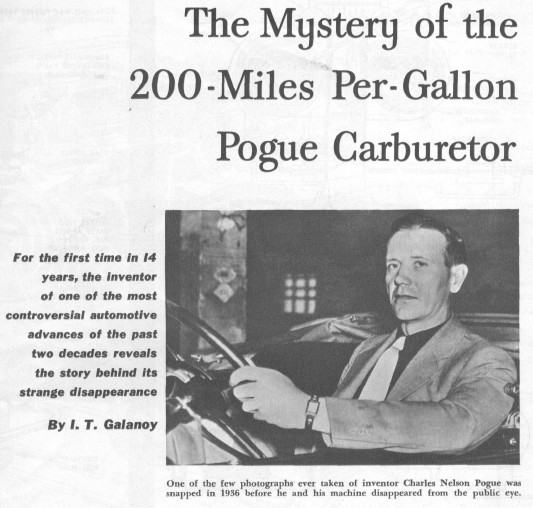
Shrouded in the vagueness of time and forgotten document. Pogue and his carburetor have become world-wide legend. Whenever automotive minded people get together, whether they be technical brains or garden-variety motorists, the talk sooner or later turns to “that man from Canada who invented the 200-mpg carburetor” Sunday newspaper supplements and syndicated columnists perennially rediscover the item and wonder about rumours that Pogue was kidnapped, murdered, beaten, bought off.
Wonder no longer.
For the first time in 14 years Charles Nelson Pogue spoke to a reporter. I am that reporter and this is his story.
In the opening months of 1936, stock exchange offices and brokers were swamped with orders to dump all oil stock immediately. Imperial Oil of Canada, for instance, suffered a six-point drop. Why? Well, during June and July of the previous year, it was rumoured that a small eight-cylinder coupe fitted with a mysterious carburetor had driven from Winnipeg, Manitoba to Vancouver, British Columbia- a distance of 1,879.5 miles- on 14.5 gallons of gasoline for an overall average of around 130 miles per gallon!
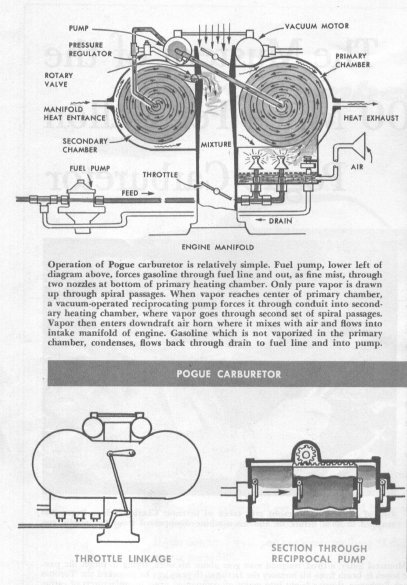
This was not the first time however, that the carburetor had made news. Since Pogue had started on the invention some 17 years before (about the send of World War I) and there had been earlier impractical models, Pogue had created whispers throughout the North American continent. Oil men snickered at the idea and most motorists laughed off the news of the invention as just another illogical contraption.
However, in 1936 the manager of one of Winnipeg’s largest automobile dealerships was reported in the authoritative Canadian Automotive Trade to have said: “Today I drove a coupe with the Pogue carburetor 216.8 miles on an imperial gallon of gasoline (roughly the equivalent of a gallon and a fifth in the United States ). The car performed perfectly in every respect… I was able to throttle it down to one mile an hour and the car pulled along smoothly and steadily.”
The president of a leading automotive agency in the same area (which was Pogue’s original home and birthplace of the invention) was quoted by the Schrader Service News of Brooklyn, N. Y., for summer, 1936 as saying; “I made a test today of the Pogue carburetor installed on an eight cylinder coupe. The speedometer showed that the car had run over 8,000 miles. I drove the car 26.2 miles on one pint of gasoline. The performance was 100 per cent in every way.”
An engineer in a Canadian automobile plant was quoted as saying: “At the time of testing we covered 25.7 miles on one pint of gasoline.”
In addition to these personal testimonials, other articles appeared in the daily press and automotive trade journals about better idling, faster pickup and in one case, a test car which was kept in an unheated garage during a cold Canadian winter offered no starting difficulties during a cold Canadian winter offered no starting difficulties during the entire period.
Overwhelming controversy met these testimonials. The December 12, 1936, issue of Automotive Industries said: “It stated that on the announcement of these results (216 miles per imperial gallon ) the stocks on the Toronto Exchange took a tumble, that men of great wealth or powerful political connections are financing the development, and that the inventor’s laboratories have been broken into in two different instances and working models were stolen…it is added that the stolen models were incomplete…if the inventor could substantiate the claims, the consequences would be most important …fails to show any features hitherto unknown in carburetor practice and absolutely gives no warrant for crediting the remarkable results claimed… we shall remain exceedingly sceptical.”
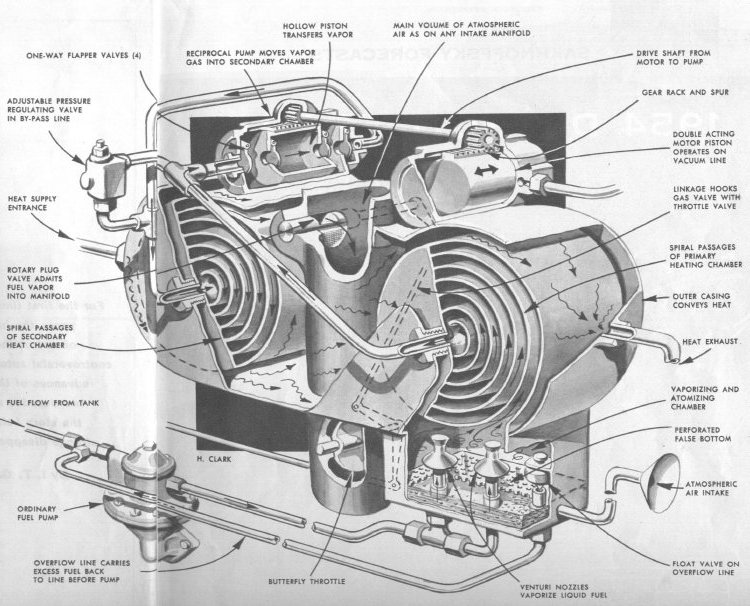
Other articles at the time said that the carburetor was too impractical for use in the ordinary course of driving because it was dangerous. These writings pointed out that the Pogue carburetor was liable to explode at any time.
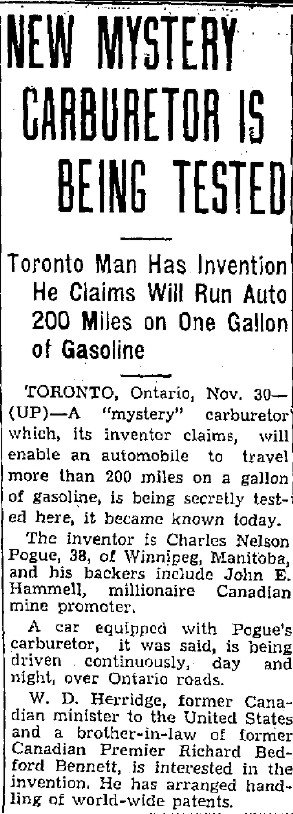
Scores of carburetion experts and oil company engineers made public pronouncements on the impossibility of the sevenfold increase claimed by the Pogue invention. One oil company engineer even pointed out that gasoline did not, nor never could, contain that high a percentage of explosive power.
But the fact remains that Charles Nelson Pogue was the holder of some five American and seven Canadian Patents issued to him between 1928-1936. The Canadian Patent Office lists the first patent for an improvement in carburetion as filed on April 3, 1928 and the last on June 23, 1936. The first United States patent was issued on March 11. 1930. from an application filed August 20. 1927. and the last was issued on January 7. 1936. Since the life span of a patent is 17 years, Pogue’s last legal claim to his controversial carburetor runs out this year.
Columnist E. V. Durling wrote in a 1949 column. “Some organisations make a practice of waiting 17 years for a patent to expire and then start to manufacture the patented article… that brings to mind that there was patented in the United States in the early 1930s a carburetor said to make it possible for an automobile to travel from 150 to 200 miles on one gallon of gasoline…it has never reached the market. However, the patent on it expires in a few years, I can hardly wait to see what happens then.”
Neither can Charles Nelson Pogue.
Now the general manager and part owner of a dingy second floor machine shop in Montreal which specialises in the production of oil filters and filter elements, Pogue is anxious to see if anyone will succeed where he did not.
Each time his story is “rediscovered” Pogue is swamped with mail from all 48 states, all provinces of Canada and at least 29 foreign countries. His fame is so widespread throughout the Dominium that a letter addressed to “Pogue, Canada” and mailed in San Antonio, Texas., once reached him in three days.
Although he is not in hiding ( the Montreal telephone directory lists his home address and telephone number). Pogue has a healthy dread of mail influxes which arrive at his home or office. Each mention of the carburetor seems to drive deeper his painful memory of the invention and his life with it.
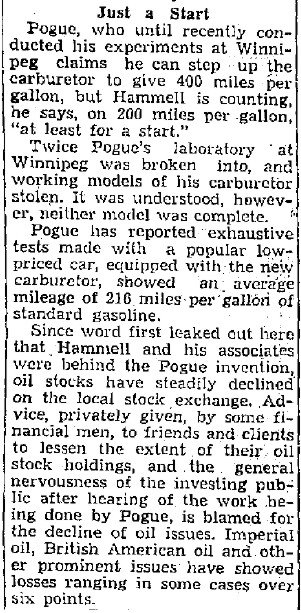
Pogue is reluctant to talk about his invention. He spoke to this reporter, “only because you’re from New York and you’ve come this distance. I haven’t seen a reporter or talked for publication in 14 years.”
When reminded that he was the central figure in a controversy which had never been been settled and further, that he was now a legend to a new generation Pogue said: “I don’t want to hear about that. I have nothing to gain by telling my story. If I knew I were to die tomorrow or if I were leaving the country, I would tell it…. and it is quite a story. I’m alive and this is my house…”He waved a tired hand in the general direction of downtown Montreal.
But, then, with prodding he admitted that his own automobile ran for ten years on one of his carburetors but he refused to divulge performance figures for that period. Further, he denied that he ever claimed that invention offered 200 miles to the gallon-or even half of that. When pinned down, however. Pogue refused to name the figure he claims has been “violently distorted by newspapermen and magazine writers.”
He admitted that when news of his invention first became public, he was approached by many people. ” A lot of them said they were inventors and wanted to buy stock, wanted information, wanted controlling interests. I later found out most were from oil companies.”
“Were you ever threatened, Mr. Pogue?”
“Yes, several times.”
“Were you ever physically attacked?”
“No.”
“Was your workshop broken into and models stolen?”
“Several times.”
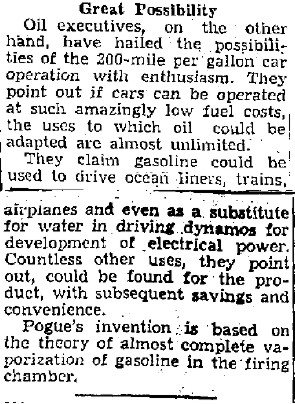
“Were you ever the victim of political pressure?”
“What do you think? Say you’re a government official and you’ve got oil stock and my invention came along. What would you do? I had pressure from both Canadian and American politicians. One of your fellows, a big shot in Washington now, was one of them.”
“Will you name him?”
“No.”
“Does automotive failure face all inventors of revolutionary new products?”
“No, providing they invent something easy to make. Now take a carburetor, one of the hardest things to make. I lost $100,000. My partner, that’s his picture up there, he lost $100,000. We spent over $20,000 just making dies. They’re all in the next room. We use them as junk.”
“Why didn’t you produce the Pogue carburetor?”
“Firstly, we couldn’t get materials, then distribution, then the war came along, then…”
“There’s a story which says you were bought off. Is this true?”
“No.”
“The carburetor is still yours then until all patents expire?”
” Did you try to sell the rights to your invention?”
“Where? The companies buy from their own suppliers to make that double profit. What company would give this carburetor away? Change a little bit of chrome here and there, that’s all they do for competitive purposes.”
” Don’t you think the public would have bought your carburetor for installation on standard cars.”
“I don’t want to talk about it anymore”.
And that was the unsatisfying end of Charles Nelson Pogue’s first interview in 14 years, perhaps the last time Pogue will speak about his invention to anyone.
Earlier, in the two-and-a-half-hour interview, this information came to light:
Charles Nelson Pogue, tired and frightened, is hiding a great deal of information for no apparent reason that I can fathom. Although visibly moved when confronted with the picture of young inventors who might be aided by his experiences, he would not tell his story. Even when confronted with the fact that many readers would consider his refusal to speak a certain indication of fraud, he merely shrugged. He refused even to pose for pictures and threatened prosecution for invasion of privacy if photographs were taken against his will.
One emotional moment came when he was asked if his invention was dangerous. He leaped up, towered over his gadget-strewn desk and waggled his forefinger: “That’s nonsense. Gasoline will not explode unless it has oxygen. In my invention the gasoline was heated before it mixed with air. Its entirely possible many people misunderstood that, but my invention would never explode. Never!”
He also disclosed that the first rash of publicity brought letters of inquiry from governments of Italy and Canada and personal visits from representatives of Nazi Germany and Communist Russia. He hinted darkly at financial and political considerations offered to him by these governments but, when pressed for details, refused to continue.
Taking another tack. Pogue pointed out that the United States and Canadian patent offices hold thousands of carburetor patents which are superior to those in use. And yet they are never investigated by the manufacturers, according to him. In the same vein, he described the steam automobile as “the most practical vehicle ever designed” and asked why it has been discarded. He believes that if as much research had gone into steam propulsion as into the gasoline engine, all early objections to that form of locomotion could have been eliminated.
“Why?” he said, “Ask the companies why.”
He claimed he received a letter of invitation to submit his carburetor to the United States Government during World War II. Pogue wrapped up his invention and travelled to Washington, checked into a D.C. hotel. Although he flashed the letter, government officials refused to see him, finally ended by sending him to a test laboratory in a government building. There, Pogue found the man in charge to be a dollar-a-year engineer. His momentary puzzlement over the familiarity of the man was soon evaporated when he recalled that this individual had approached him in 1936 as an investor.
“Naturally,” Pogue commented on his Washington trip, “they kept me waiting around two weeks in my hotel room and ended by turning down the carburetor”
However, a letter written by a firm of Canadian attorneys to Alan Gooden, a young New Jersey resident who actually makes a living selling information about Pogue carburetor, pointed out that the Canadian Army had run tests on the Pogue carburetor during World War II and found that although mileage per gallon had been increased, that increase did not offset the tremendous loss of engine power which they encountered. Official Canadian sources, however, claim to know nothing of such tests.
Basically, the Pogue carburetor created no new principles of carburetion. Similar to an ordinary perfume-bottle atomiser, any carburetor mixes mixes a high percentage of air with small percentage of gasoline to create an explosive mixture. Generally the proportions runs 13 to 17 parts of air to one part of fuel. When mixed in the case of gasoline, falls instead of rises like other gases. Strangely enough, this fact was overlooked for years by manufacturers and all production carburetors were of the updraft type. t wasn’t until the early ’30s that downdraft carburetors were introduced.
During the late ’20s and early ’30’s so many fuel-saving devices were patented and placed on the market in the United States and Canada that the National Bureau of Standards in Washington created a special department to handle the testing of devises. For a fee of $35, the Bureau tested devises and informed their sponsors as to whether the claims made for the invention could be substantiated. The average claim for gasoline savings with this influx of gadgets was 25 per cent. Although Pogue’s claim made the others seem negligible by comparison, it still excited no undue comment until the first “personal testimonials” came out of Winnipeg in 1936.
Judging by today’s standards of what constitutes good mileage, the Pogue claims indicated a fantastic increase in one fell swoop. Is it possible?
There is a certain maximum economy mixture of gasoline and air ( generally conceded to be about 16 to 1). If a carburetor delivers this with the air, this is accepted as the best it can do. Actually, “the best” is possible only under ideal conditions. That is, a one-cylinder engine operating under a constant load-fluctuations in power would upset the entire mixing process.
The gas-air mixture going into the the multi-cylinder engine are not even. To give maximum gasoline mileage, any carburetor should be adjusted down to the leanest (least gas) possible mixture. But, if this is done, the mixture may become so lean in one or more of the cylinders far away from the carburetor, that those cylinders won’t fire at all. A richer mixture is generally offered for everyday use to make sure that every cylinder is receiving a proper amount of gasoline. In addition, a richer mixture offers better acceleration and slightly more power.
The matter of gasoline engines efficiency is one which has stumped automotive engineers since the advent of the horseless carriage. Because of the high power losses in the carburetor, in the exhaust gases, and low power factor at which engines work, gasoline has never been delivered its theoretical potential.
What, then, did the Pogue carburetor do to overcome these power losses and offer the mileage claimed?
Basically, the Pogue carburetor heated the gasoline before mixing it with the air. With this system, the inventor claimed that the imperfect mixing of gasoline in air ( which resulted in small unvaporised droplets of gasoline which do not explode, which burn slowly, unevenly and increase internal heat- all bad for performance and mileage ) was eliminated and every possible energy unit in the gasoline was being utilised.
To provide a perfect gas-air mixture for the engine, Pogue believed that a heating chamber was needed to thoroughly vaporise the gasoline before it joined the air stream and entered the cylinders.
Although automobiles do have a heating chamber built into the intake manifold, this chamber heats the gasoline and air mixture only after it leaves the carburetor Although this helps the automobile to start easier and warm up faster, it also creates an expansion of air and consequently, a smaller charge of air-gas mixture is drawn into the cylinder. Pogue decided that the only way to produce a real gasoline vapour was to heat the gasoline and not the air.
His first vaporising carburetor (1930) had a single chamber with hollow walls which allowed hot exhaust gases to circulate through the carburetor and warm the gasoline in the chamber. When heat ed the gasoline should turn to vapour. But there were no great claims made for this particular model.
Later, in 1935, Pogue turned up with an improved carburetor which featured two vaporisation of the gasoline. And this is the carburetor which started the oil-stock tumble.
Pogue admitted to little difficulty in starting the car however, for the gasoline was not warm until the exhaust gases reached it. So the first charge of gasoline going into the engine was far rawer than those later when it had been heated.
But with the exception of this one minor flaw, Pogue still believes his carburetor is completely practical.
So the mystery of the Pogue carburetor lies not in the devise itself, but in the semi-secret story surrounding its invention, development and eventual abandonment.
In a further effort to clear up some of the most controversial aspects of the case, CARS contacted R. Pepper, now editor of the Canadian Automotive Trade, the publication which originally printed some of the most sensational testimonials.
First, could CARS have a copy of the original article?.
“I am sorry but there are no back issues or photostats of the 1936 article on the Pogue carburetor available.”
What about the original reports which were printed? Were they true?
“The carburetor never was a practical success and the original report was entirely misleading as there was no expert ever tried it did give the mileage suggested in the article.
And then, as an added bonus, Pepper volunteered: “It might interest you to know-if you do not already know it- that it is impossible to get more than 45 imperial miles per gallon a 3000-pound standard production vehicle with a 100-hp engine under ordinary driving circumstances.”
Impossible? Not according to Charles Nelson Pogue.
Although he will not reveal his exact age, Pogue is not yet an old man. His face shows the strain of years and the back of his hands are latticed with a network of fine lines and veins which are the trademark of the man who dreams with his hands.
http://www.carbongoodguys.com/charles-nelson-pogue-vaporiser-carburetor-1936.html
The full patent can be seen at
www.google.com/patents/US2026798
Today
Alternatively, for detailed instructions on how to make your vehicle extremely fuel efficient ( to run your car on fumes ) see our page
Run your car on vapors


1-1/2 inch diam. in-line valve for $15
the T fitting: 1-1/2 inch diam. = $3
1-1/2 inch diam. vinyl tubing = $3/ft
Run Your Car On Vapors
Car gets 400+ MPG John Weston
Super Carburetors
Tom Ogle Carb.
Ogle in Argosy mag.
A Hydrogen Generator You Can Build







All this sounds great if oil companies do not snuff anyone with a great idea? Kent
The Bureau of mines says the lower flammability number for gasoline as a vapor is 3%.
And you have no idea what the lower explosive number for gasoline as a vapor means. Would someone like to tell him? (see our page “Run Your Car On Vapors”)
to William Sharper
Who owns the rights, the patent ran out decades ago. it is public domain. – ted woodard
I’d never read the true story before, fascinating. Growing up in the fifties I had heard of Pogue and the 200 mile per gallon carburator but the story was that an oil company executive invited the inventor on a fishing trip and he was never heard of again! Amazing the information you can get on Google.
– Ron Rich
Hi, I would like to have the EP130. Are you selling it and at what cost? Do you have a specific website? Or do you have a hho kit that works 100% for a 2-3 l car? Can you deliver in Canada and what are the requirements?
Regards,
Jean
Can you put a little gasoline in the bottom of a gas can, and run you car on vapors? (see our “Run Your Car On Vapors” page)
Mesdames, Gentlemen: Who owns the rights to the Pogue? I am having trouble discerning the rightful owner.
William Sharper
Read this page. The answer is clear.
Have a 2012 honda civic will it work, and can I buy one? How much? And are they easy to install?
I guess you did not read Bruce McBurney’s comment (2nd below).
The image on Pogues Patent on the USPTO Website is almost deliberately horrible. The image on this website provides sufficient info for anyone to build one of these. It is basically a heat exchanger that uses the heat from the exhaust gasses to take the fuel to the monotomic level so that each molecule can react with oxygen instead of droplets burning from the outside inwards.
Today we have the benefit of building one of these with off the shelf items like aluminum roof flashing for the heat exchanging coils, a used fuel injector and fuel pump from a upick junkyard (~$10us) for the atomizer, a 12v air mattress blower motor for the air pump, if you can manage with these, then you can figure out the rest.
If such a contraption were mounted on a fuel injected engine upstream of the mass airflow meter then the oxygen sensor should notice the excess fuel and shut off the cylinder injectors proportionately. You also won’t have any issues with cold starting on a fuel injected platform if you use a radiator fan sensor switch and a relay to kick in your Rogue Pogue that way it doesn’t kick on until the exhaust gases are up to temp. A double 12v gas valve from an old RV furnace can be used to downstream of the blower motor and drill a hole in a brass compression cap as an orifice sized to match the engine.
Build one, use it (like Pogue did), stay out of the limelight and no one will bother you.
Rogue Pogue
A POGUE CARB IS ON SALE ON E BAY SEE number 261284356583
1400.00 looks very well made, but it could be fouled up with leaded fuel
I researched super carbs and found out that Pogue and most inventors did not fully understand what they were doing, they all thought it was just vaporizing the gasoline, but I found and proved that to get the great mileage you have to crack or re refine the fuel into natural gas and methanol. Please see and share out my web site http://www.himacresearch.com. Please contact me if you want to help get this built.
It is time to end suppression before it causes the end of us. Global warming is real but being slowed down by chem trails, that are aluminum and reflective materials that are destroying our soils
I am very interested in obtaining a “Pogue Carb” In what way can and will help me?
where can I find Pogues Carb and full patent with all of its drawings on the internet?
google.com/patents/US2026798
Very interesting article. I acquired the ‘Pogue Patent’ in the 70’s and began work. Not only does the vehicle get good mileage but the engine idles and runs extremely smooth. Now I am too old and too worn down to continue the work but I know it exists.
how can I get one of these vapour carburettors ;is there anyone making them as a kit you can just bolt on?
Gents:
I have been given permission by GM to pursue both Hummer and Saturn. Saab, Opel and Ford subsidiaries in England and Russia are open to be acquired. They know that the combination of high mileage cars and lithium air batteries are coming and they cannot do a damn thing about it.
Further, too many people know the truth. The dissemination of facts cannot be stopped either. Stop bitching guys. Let’s do something. Act.
I plan to develop these technologies and combine them with free energy aspects to boot. For example, not only have my team made a Pogue fuel injectable, but they have also managed to tie a motionless electromagnetic generator to the lithium battery. The result: nearly 180 mpg, with no need to recharge the lithium battery for 25,000 miles. Just think of it. They have also managed to tie in shocks, and breaking to the lithium recharge.
To close, maybe being ex-military (intelligence, Air Force) makes me a bit more optimistic. I know we can do this, and this is indeed the time.
William C. Sharper
dream on
Built a vehicle few years ago. Blew the hood off it.might have hit 65 mpg…
Colin McGregor
Guys just so you know. be carful as i found another site that had heaps of history make sure you got a way to get away safely after you reveal the idea as many people have died tiring to reveal there ideas.
The fact that there are many other sites providing the same or parallel information demonstrates safety in numbers.
However it won’t help to apply for a patent or fool themselves into thinking they can get rich making and selling their idea or invention or dreaming that someone else will make them rich making and selling their invention. Forget it. Everyone should read our pages about Nikola Tesla, C. Earl Ammann, Lester Hendershot, Alfred Hubbard, T. Henry Moray, and Ed Gray.
-ed.
keep up the good work and could you discuse a little about hho gas as it started 20 years ago and the guy that was able to operate his car on 100% water before big money killed him, thanks.
It started as far back as 1908 (perhaps even 1806!). See that and more on our page “Hydrogen Powered Cars, History of”
– ed
We are being ripped off by the gov and the oil com, elec com, and it does not end there. And the list just keeps going. I could tell you storys that would cure your hair. But that’s another story.
Didn’t these super carbs work due to the principles of catalytic cracking? Seems like I saw that on this web site last year, but can’t seem to find word one about it now. Am I missing something?
Then when they introduced the lead to gasoline, that’s when the super carbs began to have problems.
It is McBurney who tells all about catalytic cracking. See our “McBurney Super Carb” page.
We have looked for more than just “coincidence” in the timing of the introduction of leaded gasoline. Our pointed comment is a few paragraphs below Don Garlits photo.
-ed
I will have a carburated engine running by the end of 2011, at 100 plus mpg. Werconst [at] yahoo.com
John
hi,where can i get a working Charles Nelson Pogue carburetor
and detailed plans on how to make one, it can be used to run generators in remote parts of africa.
Forget generators, consider all the 18 wheelers, diesel trucks, getting about 4 mpg, who could be getting 60 mpg!!
The best drawing is here on this page. You could make a fortune selling them to truckers, till the oil co’s find out and you suddenly quit breathing.
-ed
Hello!
My name is Ayhan from Romania ,and I want to know where I could find this amazing carburator. … With all my consideration and respect, – Ayhan